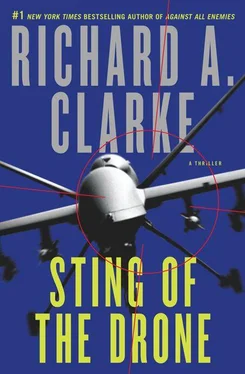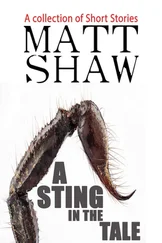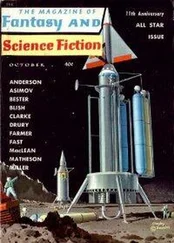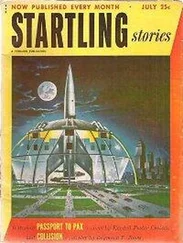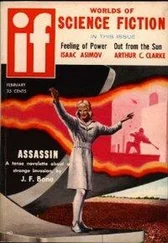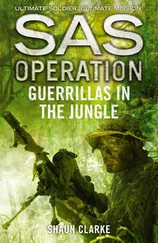“That’s a U.S. Reaper D the Chinese are selling,” Sandra said to Ray as they walked by.
“Yeah, they hacked in and got the plans for the modified Reaper,” Ray replied. “But it looks like they have improved upon it.”
A flat screen at one of the booth displays was showing WWN. The BREAKING NEWS logo appeared and both Sandra and Ray instinctively walked closer to hear the newscaster. “…exclusive film of the orphanage blown up by the American drone inside Afghanistan three days ago. We warn you that this report from WWN war correspondent Bryce Duggan is disturbing.”
The screen switched to a young American standing in front of the charred ruin of a house. “We have been told this building used to be an orphanage. What is clear is that children lived here, or rather died here. This video, provided to WWN by a local tribal elder, shows what is definitely this same building still smoking after a fire and here, inside, on the video are what appear to be the partially burned bodies of little boys, many of whom appeared to be in their sleeping bags when they died.
“We arrived two days ago in time to see the burials, which took place at sunset hours after what several of the locals told us was a drone attack. The tribal elder also gave us a video of what appears to be a U.S. drone firing missiles into what is almost certainly this area. We cannot account for the authenticity of these tapes, but we interviewed numerous villagers, including some we chose at random, all of whom confirm that they heard and then saw a drone overhead prior to what they say was a missile attack on this house. They say there are no al Qaeda people here, no terrorists, but they do say that they themselves would do harm to the Americans who did this attack on them, what they call this unprovoked attack. The American Embassy in Islamabad would not comment to this reporter, saying only that they do not discuss intelligence, and referring us to Washington. Bryce Duggan, World Wide News, reporting tonight from Waziristan.”
Sandra Vittonelli’s secure mobile phone vibrated in the left pocket of her jeans. It was Erik. “Boss, sorry to bug you on your day off. We have a problem. Looks like we may have had some collateral on that strike against those Qazzani HVIs on the AfPak border. And Dr. Burrell’s office just called to say he wants you and Mr. Bowman on a videoconference with him at noon our time. Where are you now?”
TUESDAY, OCTOBER 13
U.S. CAPITOL BUILDING
WASHINGTON, DC
They were up high, inside the dome of the Capitol. Ray Bowman’s legislative liaison officer had arranged for their black Chevy Suburban to be cleared through two gatehouses, allowed to drive onto the Capitol Plaza and then to park behind the main exterior staircase just below the Rotunda. He then escorted Ray and Sandra Vittonelli quickly through the magnetometer and the Capitol Police, past a tour group, to a small elevator door behind a velvet rope. The tiny elevator had shot them from the ground level of the cavernous U.S. Capitol building to the most secure hearing room on Capitol Hill, and the highest, built into the side of Bulfinch’s great dome.
The hearing room was used for briefings, but not public ones, only secret and top secret. There were no seats for the press or public, no television cameras from C-SPAN. Before Ray and Sandra were allowed into the room, Capitol Police took their phones and then ran wands over them to make sure there were no other mobile devices in their pockets. Inside, there were only Members and staff of the House Permanent Select Committee on Intelligence (HPSCI), or as it was known around town, “hipsy.” The committee were Members of the House of Representatives, elected to Congress from across the nation and sworn to secrecy about the workings of the U.S. intelligence agencies that they monitored on behalf of the House.
All the Members of the House were running for reelection in three weeks, but instead of campaigning back home, they were still in session because the President and Congress had not yet come to an agreement on a budget to fund the government in the fiscal year that had begun two weeks earlier. While the Congressional leaders tried to work out a compromise, some Members held hearings hoping to get media attention back in their districts. Unfortunately for the Intelligence Committee, its hearings were not televised. That combination of facts made the Members of the Committee somewhat out of sorts.
The Chair was Roberta Levinson, a liberal Democrat from Massachusetts. The legislative liaison officer had called her “Bobbie the Bitch” during his prebrief in the Suburban as they had driven up to Capitol Hill from Ray’s offices in Foggy Bottom on the banks of the Potomac. Ray had told him that was an inappropriate comment. Levinson may have come from the same party as the President, but she was a bit further to the left of the political spectrum than the Commander-in-Chief. As soon as Bowman and Vittonelli were seated, Congresswoman Levinson opened the hearing with a gavel.
“We’re here today as part of our ongoing oversight function on the use of armed Unmanned Aerial Vehicles by the U.S. Intelligence Community.” Some Members were still drifting in and getting seated. “We requested two senior officials with responsibility for the operation of the program and we have with us today Raymond Bowman, Director of the Policy Evaluation Group, and Sandra Vittonelli, a CIA officer assigned to the multiagency Global Coordination Center for UAV Operations. Welcome.”
Ray’s staff had set up video screens on which he intended to show the Members some film of recent attacks. “Madame Chairwoman, thank you for inviting us to brief you. I thought perhaps the best way to reveal what the program is like on a day-to-day basis would be to show you a short video, condensing into a few minutes the days of careful reconnaissance and consideration that go into a decision to attack a High Value Individual or a signature-based facility on the High Payoff Target List.”
The Chair cut him off. “Thank you, Mr. Bowman, if you will leave the video, staff can watch it later, obviously only in the vault.” Ray did not like the way this briefing was going and it had only just begun. “I think our time can be more effectively used by getting answers to some of the questions I know my colleagues on the Committee have, and I know I have. Let me start by calling on Congressman O’Connell, the gentleman from California.”
Sandra Vittonelli had never been at a Congressional briefing or hearing before. She found herself both charmed and intimidated by the formality of it, the wood paneling, the gavel, the formal language, and the fact that the Members sat behind a long curved, wooden dais raised three feet above the witness table. But the formality and courtesy quickly ended.
“Thank you, Madam Chairwoman,” Paul O’Connell began. “I want to start with how it was possible, if you actually do all this reconnaissance and review before killing people, how it was possible that you bombed an orphanage and killed over a dozen little boys. Can you explain that to us? Do you want us to show you a video, the WWN video of their charred, little bodies?” The legislative liaison officer sitting behind Sandra slipped her a handwritten note, “From Napa Valley, and overly fond of the wine.”
Ray took the incoming spear. “Congressman, we have investigated the incident you refer to, including an independent examination by our Inspector General. We do not believe it was an orphanage. We believe it was a trap designed to discredit the UAV program.”
Congressman O’Connell leaned forward, his chin almost touching the microphone in front of him. “Well, it certainly did discredit the program. You didn’t have checks and balances, internal controls in place to notice that there were a bunch of little boys in the building?”
Читать дальше
